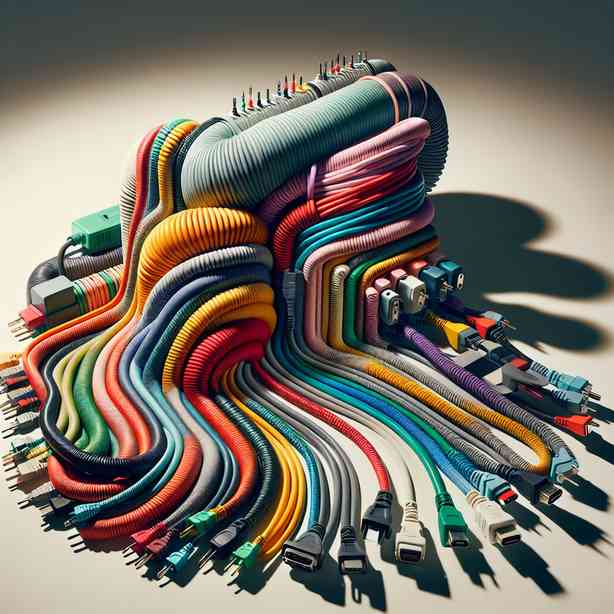
Cable management is an often overlooked but crucial aspect of maintaining an organized and efficient workspace or home environment. In our increasingly digital world, we rely on a multitude of devices that require power cords, data cables, and other connectors. As a result, the chaotic tangles of wires can lead to frustration, lack of productivity, and even potential dangers. Understanding the importance of effective cable management is the first step toward achieving a tidy and functional space.
To begin with, one of the primary reasons for maintaining good cable management is the visual appeal it brings to a workspace. A clutter of wires can be overwhelming and distracting, detracting from the overall aesthetics of an office or home setting. When cords are neatly arranged and organized, they not only look better but also promote a sense of clarity and focus. This can improve your mood and productivity, as you’re less likely to be distracted by the visual chaos that messy cables create.
Another significant advantage of effective cable management is safety. Excess cables can pose tripping hazards, which are especially concerning in high-traffic areas or homes with children and pets. Furthermore, tangled cords can become damaged over time, increasing the risk of electrical issues or even fires. By implementing proper cable management techniques, you can minimize these risks and create a safer environment for everyone.
Now, let’s discuss various methods and tools that can help you achieve effective cable management. The first step in this process is to assess your current setup. Take a close look at the cables you have and determine which ones are necessary. Sometimes, we accumulate a number of cables that are no longer useful. By decluttering and removing excess cables, you can immediately enhance the space.
After you’ve sorted through the cables, it’s time to think about labeling. Whether you’re setting up a home office or organizing your entertainment center, labeling cables can save you a lot of time and frustration in the long run. You can use simple tags or stickers to mark each cable according to its function or the device it belongs to. This way, when you need to unplug or switch out a device, you’ll know exactly which cable to disconnect.
Cable ties are another valuable tool in the quest for organized cables. They come in various forms, from reusable Velcro ties to traditional plastic zip ties. A great technique is to gather similar cables together and secure them with a tie. This prevents knots and tangles while keeping everything in one place. For those who may need to make changes frequently, Velcro ties are particularly useful, allowing you to easily adjust the organization without damaging the cables.
For those with a more extensive setup, such as multiple devices on a desk, consider using cable boxes or management sleeves. These products can hide unsightly cables and keep everything neatly bundled together. Cable boxes are especially handy for power strips and multiple connections, transforming a multi-cord chaos into a neat and tidy storage solution.
Another aspect to consider is the cable routing. If possible, plan for how cables will travel from the wall outlet to your devices. Ideally, cables should run along walls or under desks to minimize visibility. Use cord clips or adhesive cable organizers to secure the cables in place and prevent them from dangling or obstructing movement. This not only enhances the look of your space but provides you with a clean path for vacuuming and cleaning.
Let’s not forget about the importance of future-proofing your cable management. As technology evolves, you may find yourself acquiring new devices that require different types of cables. Consider investing in a multi-cable system that allows for easy updates; using modular cable management systems can make adjustments simpler as you integrate new technology. Evaluating your needs periodically can also help you stay current and organized.
It’s essential to keep in mind that cable management is an ongoing process. As you introduce new devices, cables will inevitably accumulate again. Schedule regular sessions to review your setup and make adjustments as necessary. This will not only keep your space looking fresh but also ensure that you retain the safety and efficiency that good management practices offer.
Finally, let’s consider the impact of ergonomics in cable management. A well-organized workspace should also consider how easily you can access your devices and cables. Ensure that frequently used cables are positioned for easy access, while less-used cables can be tucked away. This creates a more user-friendly environment and prevents frustrations when plugging and unplugging devices.
In conclusion, mastering the strange art of cable management is about more than just aesthetics. It enhances safety, improves productivity, and contributes to a more pleasant workspace. By dedicating the time to organize and maintain your cables, you can create an environment that allows for efficiency and focus, ultimately leading to a more enjoyable experience in both work and leisure activities.
Remember, whether you’re just starting or looking to improve your current setup, the principles of effective cable management remain the same. Work methodically through your cables, implement practical solutions, and establish a regular maintenance routine. With these practices in place, you can transform your tangled cords into a harmonious and organized display, paving the way for creative and productive endeavors.


